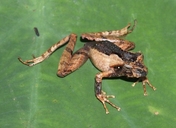|
Description
M 27-30 mm, F 28-31 mm. Hand without webbing, foot webbing 1(1), 2i/e(1), 3i(2), 3e(1), 4i/e (2), 5(0.5-0). Dorsal skin very granular. Usually with distinct but often discontinuous inner and outer dorsolateral ridges. Two large supraocular spines and heel spines present. Dorsal colour very variable. Venter whitish, without strong black-white contrasting pattern. Males with blackish paired subgular vocal sacs.
Variation: Specimens from the Ranomafana area are genetically strongly differentiated and may represent a different species; calls from these populations are not yet known. Distribution and Habitat
Country distribution from AmphibiaWeb's database: Madagascar
Andasibe, Andrangoloaka, Ankeniheny, Antsihanaka, Brickaville, Mananara, Mandraka, Mantadia, Ranomafana, Vohiparara.
It has been recorded at 300-1200m (Vences and Raxworthy 2008). Life History, Abundance, Activity, and Special Behaviors
Habits: Males call at night on low perches, 0.5-1 m above the ground, usually not too far from streams, in rainforest. Direct development has been described from this species, but recent data indicate that in fact G. asper has free-swimming tadpoles.
Calls: Groups of 2-4 short unharmonious notes; often several such note groups are repeated in a series. Trends and Threats
This species is listed as least concern in view of its wide distribution, presumed large population, and because it is unlikely to be declining fast enough to qualify for listing in a more threatened category. However, its forest habitat is receding due to subsistence agriculture, timber extraction, charcoal manufacture, and invasive spread of eucalyptus, livestock grazing and expanding human settlements (Vences and Raxworthy 2008). Possible reasons for amphibian decline General habitat alteration and loss
Habitat modification from deforestation, or logging related activities
Intensified agriculture or grazing
Urbanization
Comments
Taken with permission from Glaw and Vences (2007).
References
Glaw, F., and Vences, M. (2007). Field Guide to the Amphibians and Reptiles of Madagascar. Third Edition. Vences and Glaw Verlag, Köln.
Vences, M. and Raxworthy, C. (2008). Gephyromantis asper. In: IUCN 2008. 2008 IUCN Red List of Threatened Species. www.iucnredlist.org. Downloaded on 18 March 2009.
Originally submitted by: Miguel Vences and Frank Glaw (first posted 2000-11-27)
Edited by: Catherine Aguilar (2009-04-07)Species Account Citation: AmphibiaWeb 2009 Gephyromantis asper <https://amphibiaweb.org/species/4580> University of California, Berkeley, CA, USA. Accessed May 19, 2025.
Feedback or comments about this page.
Citation: AmphibiaWeb. 2025. <https://amphibiaweb.org> University of California, Berkeley, CA, USA. Accessed 19 May 2025.
AmphibiaWeb's policy on data use.
|
